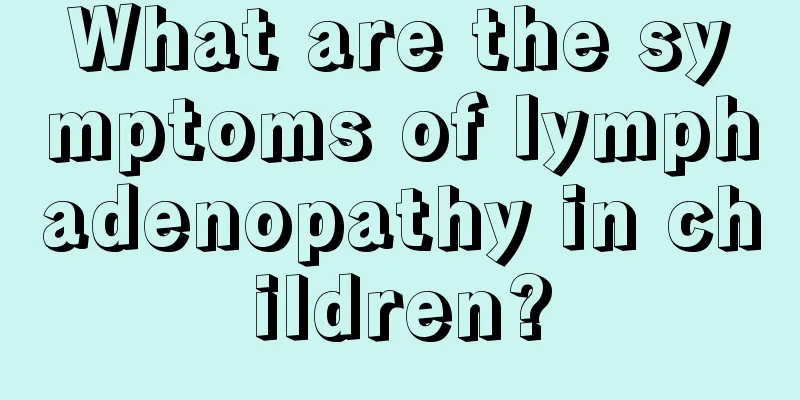What are the symptoms of lymphadenopathy in children?

|
Children are most susceptible to illness during this period because their development is incomplete in all aspects and their immunity is not strong, so parents must take good care of their children during this period. Lymphatic tuberculosis is a very uncomfortable disease. Adults are very uncomfortable when they get it, let alone children. So what are the symptoms of lymphatic tuberculosis in children? Peripheral lymphadenopathy is the most common type of extrapulmonary tuberculosis in children. It can be seen in all ages, but is most common in infants and preschool children. Tuberculosis can occur in any group of lymph nodes throughout the body, but the most common are the cervical, submandibular, supraclavicular and axillary lymph nodes. The child has no systemic symptoms except low fever. At the beginning of the disease, the lymph nodes become enlarged, hard, painless, non-adhesive, and movable. It is usually unilateral, but can also occur bilaterally. As the infection progresses, multiple groups of lymph nodes become involved. Lymph nodes may adhere to each other to form lumps, or adhere to subcutaneous tissue, and are very likely to develop caseous changes. After the caseous necrosis liquefies, a cold abscess is formed, which feels fluctuant when palpated. Children often present with a highly allergic state, manifested by a strong positive reaction to the keratin test, often accompanied by herpetic keratoconjunctivitis, blepharitis, eczema and erythema nodosum. There is a special type of lymphadenopathy called generalized lymphadenopathy, which is the result of systemic hematogenous dissemination. Tuberculosis occurs simultaneously or successively in multiple groups of lymph nodes throughout the body. Its clinical characteristics are rapid enlargement of lymph nodes, tenderness, and fluctuation, severe symptoms of systemic tuberculosis poisoning, very high fever, often in a remittent type, persistent, obvious night sweats, and the child is pale, emaciated, and generally weak, with moderate or severe anemia. This disease can be treated with anti-tuberculosis drugs. When there are severe allergic reactions and extensive perilesional inflammation, hormones, large amounts of vitamin C and calcium supplements can be added to the anti-tuberculosis drug treatment to achieve the purpose of desensitization and anti-inflammation. For local medication, if a cold abscess has formed in the lymph nodes, the pus can be drained out first, and then 1-2 ml of isoniazid (INH) solution or 1-2 ml of 10%-20% aminosalicylic acid (PAS) solution can be injected into the lymph nodes once every other day or twice a week. If the abscess has ruptured, 10% aminosalicylic acid (PAS) ointment can be applied externally or berberine gauze can be used for dressing changes. The above is a specific answer to the symptoms of childhood lymphadenitis. If you still don’t understand something, please be sure to consult a doctor. In many cases, parents treat their children as ordinary colds and fevers because they cannot see that their children have a serious illness, which delays the best time for treatment. |
<<: What are the symptoms of follicular pharyngitis in children?
>>: What are the types of cervical tuberculosis in children?
Recommend
Why does a child bite his fingers?
Many new mothers always find that their children ...
What size pillow is suitable for babies?
Adults need to use pillows when they sleep, but f...
What to do if your child has high blood pressure
High blood pressure is a very common disease. Thi...
Have you ever encountered a child with fever and cold hands and feet?
In our daily life, we often encounter some things...
What to do if your child always doesn't like to eat
Many parents are troubled by children's refus...
Will pinching your baby's face cause him to drool?
For babies under one year old, their nervous syst...
What happened if red spots suddenly appeared on my child’s face?
Children's skin is very delicate, so they oft...
Is it good for children to eat lamb?
The disease of mutton is not unfamiliar to many f...
Can I not get the hand, foot and mouth disease vaccine? Is the hand, foot and mouth disease vaccine necessary?
Hand, foot and mouth disease is a common intestin...
What is the reason for yellow hair in children?
As children grow up, their organs are not fully d...
What are the dangers of insufficient sleep for children?
For children, lack of sleep will seriously affect...
What are the symptoms of acute tonsillitis in children?
Acute tonsillitis is a very typical disease. It i...
Symptoms and causes of fright in newborns
The newborn stage is often the most worrying peri...
What is the reason for the long thorns on the baby's hands?
Children's skin is very delicate, so it is no...
Children's armpit pimples
Children are in the developmental stage, their ph...









